#NOTHING ABOUT LADY KOTO NOTHING ABOUT HER SIBLINGS
Text
I do love the entire Kyousougiga family and think their ultimate reunion was perfect and fitting, but then I remember some of the bullshit Inari pulled when we was intentionally trying to be on his best behavior, and I am overcome with the urge to beat his face in
#kyousougiga#inari#like HE FUCKING DIDN'T TELL KOTO ANYTHING#NOTHING ABOUT LADY KOTO NOTHING ABOUT HER SIBLINGS#HE DIDN'T EVEN TELL HER HE WAS HER FUCKING FATHER#JUST LET THE SIX YEAR OLD TO FIGURE IT OUT FOR HERSELF#like I still stand by it being a pretty good father/daughter relationship#in that it doesn't revolve around koto being treated like property and she gets to beat him up for these exact reasons#like the text knows what is it doing#but man on repeat viewings only does like the depth of Inari's shitty parenting show#seasalt talks
9 notes
·
View notes
Note
🐗 Ya girl Fimeko
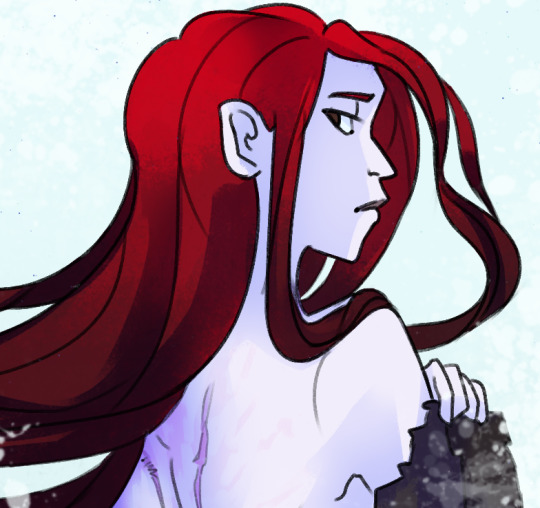
Including Image since you and wes have done so for yours so far
✨- How did you come up with the OC’s name?
According to my research, it is an archaic form of the name Himiko, which means "noble lady." A friend of mine pointed out that Fi is not a sound that exists in modern Japanese; this suits me just fine as she is from an original setting based on ancient Japan.
🌼 - How old are they? (Or approximate age range)
Fimeko is a little older than Kotone. Neither of them know their real ages, but to actually answer your question, 21-23 at the start of the story.
🌺- Do they have any love interest(s)?
Fimeko's sort-of-husband Naranbaatar. She is a slave in the court of a nomad warlord and he one of his soldiers; Naranbaatar helps her take control of the camp. A real wife guy. They never formally marry but she declares him to be her husband afterward which is good enough.
🍕 - What is their favorite food?
I've been meaning to make up food lore for the Shattered Kingdoms so here we go. There are a number of grains eaten throughout the land that come in the seven colors of the rainbow. The blue one resembles rice and the yellow one resembles millet. They can be mixed together to make a gummy green dough which is rolled out and sliced into noodles. Fimeko enjoys a soup made with peppers native to the plains, bone broth, and these rough, handcut noodles.
💼 - What do they do for a living?
Fimeko was originally a musician. She has since broken her koto and become a warlord.
🎹 - Do they have any hobbies?
Now that she's freed herself, Fimeko is taking up more traditionally masculine hobbies like horse archery and sowrdsmanship, because she believes violence is the answer. She still enjoys music, but has banned the koto from her court.
🎯🥊 -merging these
The thing she is unfortunately most talented at is playing the koto, which she hates. She loves to do violence and her husband.
❤️ - What is one of your OC’s best memories?
If you asked her she would say it's beating Lord Bakuto to death with her koto, but in her heart it's the first day she and Naranbaatar stole a kiss in private behind the lord's tent.
✂️ - What is one of your OC’s worst memories?
In her youth before she learned to play well, she would be punished frequently, often through beatings with a switch. Bakuto did not want her hands harmed so usually the strikes targeted her legs and feet, as one can play the koto sitting down. (sometime after she got good enough that punishments were infrequent, she was made to play standing)
🧊 - Is their current design the first one?
Yes, sorta. When creating her I paid little attention to her outfit; you, chesca, designed that, as well as her makeup
🍀 - What originally inspired the OC?
Reading about Queen Himiko, one of Japan's legendary rulers (according to China. They may or may not have been talking about Empress Jingu). She was allegedly a sorceress who came to the throne through manipulation and assassination, surrounded herself with female attendants, save for one man, who fed and bathed her. She is associated with fire in a lot of modern pop culture that features her.
🌂 - What genre do they belong in?
Water Maiden is a high fantasy but it dips its toes into political fantasy. She would do well in either.
💚 - What is your OC’s gender identity and sexuality?
Genderwise, cis. For sexuality, I can only say that she likes men. I will have to play with her more to see if she also likes women romantically.
🙌 - How many sibling does your OC have?
None that she knows of.
🍎 - What is the OC’s relationship w/their parents like?
Fimeko does not remember her father. Her mother is a person she cared about but rarely saw due to their situation; two slaves with different duties, kept in separate quarters. Her mother died when she was very young.
🧠 - What do you like most about the OC?
I like the arc I have planned for her, of going from a person with nothing to becoming a dominant power in the setting, the old nobody to nightmare route.
✏️ - How often do you draw/write about the OC?
I have not written very much about her in the last little while, other than revising her origin story a couple years ago. But Water Maiden is always on my mind.
💎 - Do you ever see yourself killing off the OC?
She is probably not going to outlive the novel, heh.
💀 - Does your OC have any phobias?
No but she is triggered by koto music.
🍩 -Who is your OC’s arch-nemesis or rival?
Kotone, the protagonist of the novel. They haven't met yet, but sparks will fly. In the non-sexy way. Probably. They were designed to be foils of each other, a blue water girl and a red fire girl, one sad and the other wrathful, strong reasons to hate the world but very different reactions to their respective situations.
🎓 - How long have you had the OC?
I wanna say I came up with Water Maiden in 2016, so 8 years.
🍥 - What age were you when you created the OC?
I was most likely 23. I actually came up with the core water maiden concepts about a week before my 23rd birthday but fimeko came about a month after.
4 notes
·
View notes
Text
Narasaki Ryō wife of Sakamoto Ryōma
I’ve talked about the man behind Gintoki’s main plot. One of the most beloved Japanese historical figures, Ryōma Sakamoto, the man who paved the way towards the establishment of the modern Meiji government. I’ve talked about how Sorachi had Sakamoto Tatsuma’s role more offscreen most likely because he models Ryōma’s trading business ventures, while Gintoki carries Ryōma’s more personal history. Although Sakata Gintoki references the Japanese legend of Kintaro; after certain events he became a samurai under the name Sakata Kintoki; in question corners, Sorachi explains this & doesn't intend on making Gintoki a descendent of Kintaro. Like GinTama’s Sakamoto, Oryo (Otae’s friend and coworker), has mentioned, and rejected numerous advances from ronin man Sakamoto Tatsuma. It’s a spoof on the historical figures Sakamoto & Narasaki.
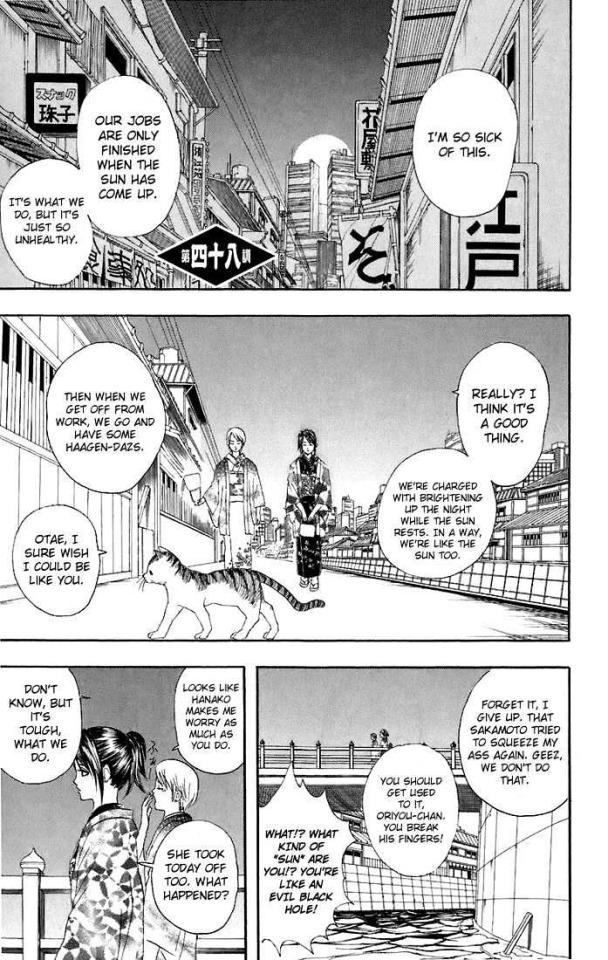
Both characters don’t appear as much as we would like but their story together have been shared and passed onto Gintoki and Otae. I wanted to talk about the woman beside the man. The woman who captured Sakamoto’s heart. I want to talk about Narasaki Ryo, a woman who pushed back against sexual exploitation and violence, and Sakamoto Ryōma, the man who fell in love with her for her strength.
This is a story so well-known in Japan it's become a just-so-story to explain the origin of honeymoons in Japan. One day in 1866, historical superstar ronin Sakamoto Ryoma is hanging out in his room at the Teradaya in Fushimi, a town just outside Kyoto. Some local guards show up hunting Sakamoto, but are overheard by a maid in the inn's bath. The maid runs upstairs to warn Sakamoto. Some versions are happy to emphasise she does this naked. He draws his Smith and Wesson pistol, and has a shoot-out with his attackers, then escapes into the night, wounded but alive. The next day he marries the woman who saved his life. They then leave the city, and sail off to Satsuma in Southern Japan, where they relax at hot springs, hike up mountains, and enjoy the first honeymoon in Japanese history.
And basically, that’s all true. Minus the honeymoon bit, which is a romantic 20th century rationalization of their escape and respite. It’s a great story, but it usually starts at the wrong place, the bit where a woman saves a man, and seems to be rewarded with marriage.

Narasaki Ryō and Sakamoto Ryōma
We know the details of Oryo’s early life from her husband’s letters to his older sister. She was the daughter of a Kyoto Imperial court physician. Oryo was the oldest of five surviving children, three girls and two boys. She had a privileged, comfortable childhood. She had the education of a cultured young lady: “trained in flower arrangement, perfume, the tea ceremony, and so on” as her somewhat less refined husband later described it. She played the koto (a stringed harp-like instrument) , wrote and read , and learned fine needlework. As the oldest sister, she took care of her younger siblings from a very young age. She would have expected her family to arrange a marriage to a young man of similar status, and to live an ordinary, refined life.

However, when Oryo was still a teenager, her father was caught up in the turbulent politics and plots surrounding the Imperial Court. He was a “Loyalist”, who wanted the Emperor to be “restored” to power in Japan. In a shogunate crackdown on these loyalists, Oryo’s father lost his position as court physician. Furthermore, many of his friends and colleagues were executed, imprisoned or also lost their jobs. The Narasaki family not only lost its income, but its network of reliable friends. A few years later, in 1862, Oryo’s father died, leaving his wife and children destitute.
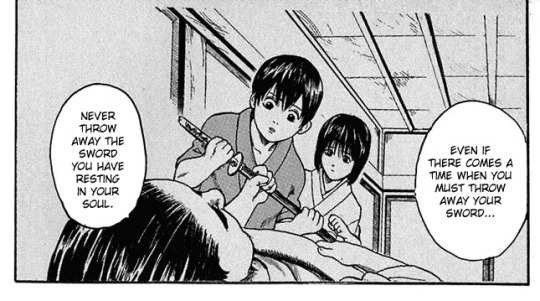
Ryoma wrote to his sister of the family's state when he first met Oryo:
They have nothing to eat and no one to look to. Sometimes they have been so hard up that they had to borrow household implements and return them after using them. They sold first their house, then their belongings, and then the oldest girl began selling her clothes so that her mother and younger sisters wouldn't have to do the same thing.

Oryo was then 22. She had one teenage brother, sisters who were 15 and 12, and a four year old brother. An impoverished family with two young girls, and no adult male protector was an easy mark for a predator.
Ryoma writes her story: But then the youngest girl, who is unusually beautiful, was duped by some scoundrel and sold into the Shimabara as a maiko; the same villain, without saying anything to the mother, took the girl who is 16 and sold her to an Osaka brothel. The five-year old boy entered a Shibataguchi temple as an acolyte.
Note: these ages are by the Japanese reckoning, by which children are born aged one, and add a year at New Year's Day. By our count, they would be at least a year younger.
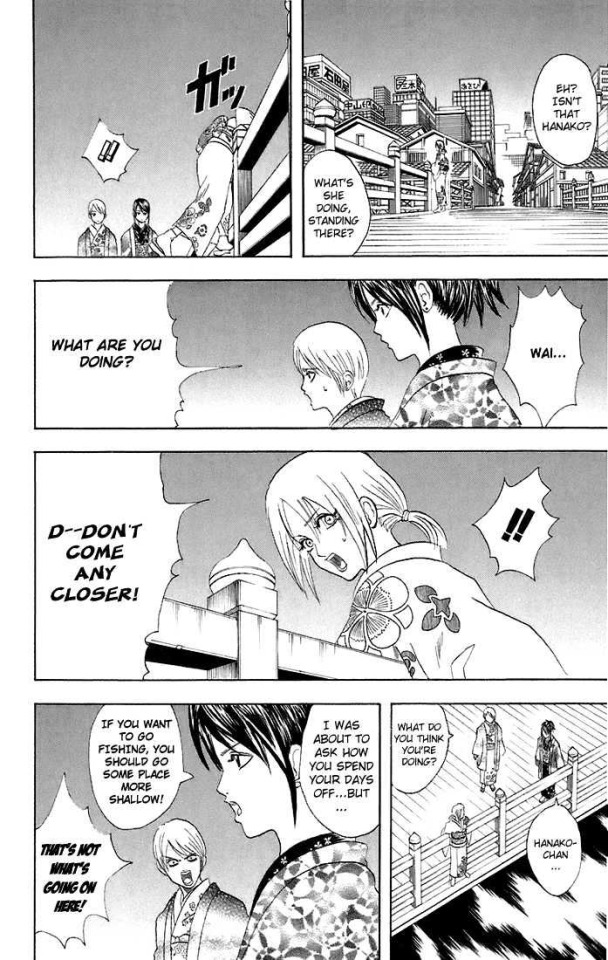
(This segment reminds me of another lesson where Otae offers her help to her young-like coworker Hanako who was duped by a swindler).
Several things have been changed & roles of Gin Shinpachi & Tae were moved around for the story.
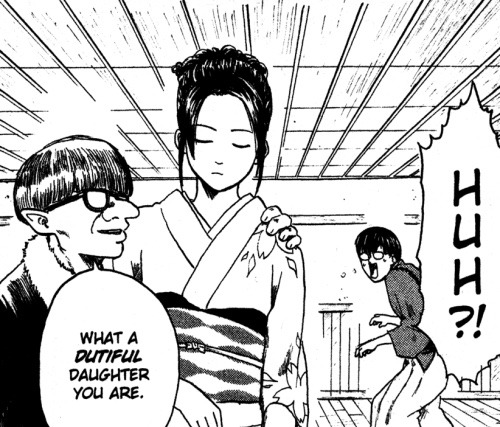
When the eldest sister realized this, she sold her last good kimono, headed for Osaka, and confronted the villains there. She didn't care if they killed her, and she carried a dagger. When they saw how determined she was, the scoundrel showed her the tattoo on his arm and shouted threats at her. But she had come prepared to die, and so she flew at him, grabbing his clothing, striking him in the face, and exclaimed that if he didn't return the younger sister he had brought to Osaka with him she would stab him. The wretch shouted, "Look out, woman, or I'll kill you!" They went at each other with shouts of "Kill!" and "Do you worst!" After all, through, he couldn't very well murder the woman who had come to Osaka, and so she was able to get her younger sister back and take her to Kyoto with her again. Isn't that a story? The youngest daughter in the Shimabara is in no danger immediately, so she has left her there for now.

It was this story which won Ryoma's love and admiration. “I must say, she has more strength than I do," he closed this letter to his sister Otome. He explains in this letter that he's helping to get her siblings places, and he's entrusted Oryo to the care of the landlady of the Teredaya, Otose. You see, he was already planning to marry Oryo, simply because he was in love with this strong awesome woman. Ryoma had been brought up by strong women. He was an immensely talented swordsman who had been first taught to fight by his older sister Otome. He would later joke that people who knew them believed Otome would win in a fight.
The story of how Narasaki Ryo fought for her family, and then was loved for her fighting spirit, is a much greater and truer story than the first one.

(Saigo, Otose & Otae)
There's a sad ending. Sakamoto Ryoma was assassinated in 1867, and Oryo faded into obscurity. Most of the men in Ryoma's life, including his own family, didn't care about supporting her. The exception, Satsuma leader Saigo Takamori was killed leading the Satsuma Rebellion. Oryo managed an ordinary life in Tokyo, marrying a merchant, adopting a child, divorcing, and living in modest circumstances till 1905. At times in her later life she received some attention from the press for saving her husband's life back in the Meiji Restoration. People said she was an alcoholic in her later years, lost in dreams of her romantic early life. Perhaps, and who could blame her? But I also know that the Meiji era became more and more judgmental of women's drinking. Many late Edo Period women could put away a lot of sake, and that didn't sit well with Meiji arbiters of proper womanly behaviour. Meanwhile, in my opinion, many of male heroes of the Restoration were functional alcoholics, who slowly were slipping into dysfunction. Let Oryo have her sake, without making that the emphasis of her life. She lived a long life, survived, and won a better life for her family.

All the quotes from Sakamoto Ryoma's letter can be found in Marius Jansen’s ‘Ryoma Sakamoto’s and Meiji Restoration’ p. 225-226.
#gintama#sakata gintoki#otae shimura#sorachi hideaki#gintae#gintoki x otae#gintama history#gintama thoughts#Japanese history
63 notes
·
View notes
Text
So Kyousougiga has a manga???
Scrolling through the Kyousougiga page to make sure I got the timeline for OVA>ONA>TV right, I discovered a manga was released just a few weeks after the original pilot dropped. While it was never officially translated, some fan groups tackled the first volume and so I thought I might as well give it a read to see what the take was on it
Overall it is definitely closer to the pilot that the TV series, but told it a simple and more digestible way. Koto mysterious crashes in the Looking Glass City with no memories while the siblings slowly start to scheme about using her a sacrifice to bring their mother back. And while it is curious to see what a conventional take on the source material would look like, it really lacks the depth as a result.
Even if Koto wasn't the type who's internal struggles could be easily read, you can really feel the different now that amnesia has made her a blank slate. Here there is nothing tying her to outside world, (even her hammer stolen from Shoko once she crashes) and the best we have to replace that interiority is a bunch of food jokes. Myoue also isn't given much reason to go to bat for her and try to depend her. Even when we get his focused chapters they spend little time together, and his depression and suicidality is replaced with essentially insinuations of being a mama's boy, and that Lady Koto's disappearance affected him the most. While there are a few lines in the pilot that also gesture to this, it makes me theorize that whatever his deal was here eventually developed into his subplot with Inari (who speaking of didn't even get an appearance or shout out in this volume)
Lady Koto's disappearance is given no reasoning beyond a line about the trio "needing to grow up" which is ignored for their happy reunion at the end. And most surprising of all, Yase is positioned as the most convincing and leader of the group. She does most of the planning and luring of Koto, while Kurama mostly plays backup. And the flashback we do get to the kids has her give bossy older sister vibes, rather than the quick-tempered brat she became. There's no subversion to her classy ojou exterior, so again working backwards I wondered if once Myoue developed in a different direction, the sibling traits were pushed down the line
So yeah I didn't find much of value besides being a curiosity (although I am still intrigued where that second volume would go) but the most important find to me was this yuri joke made about Koto and Shouko
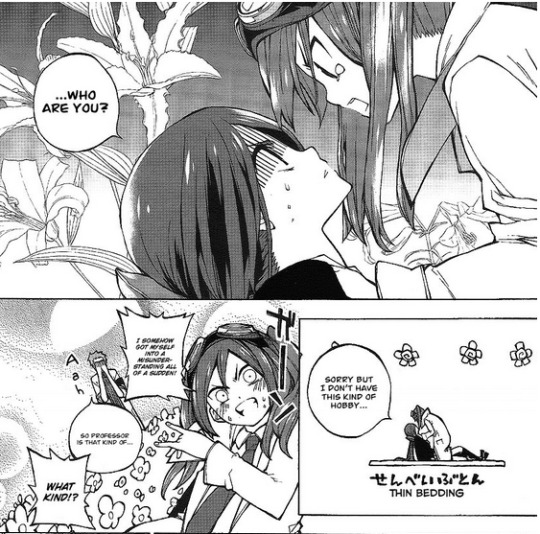
#seasalt talks#my reviews#After someone pointed out that Koto lavishes both Myoue's ex and his current gf with a lot of praise#I just can't help but think this girl is gay which is kinda amusing for a show with no romance beyond established couples just existing
0 notes